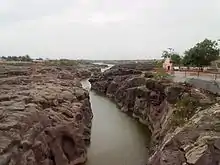Kukadi River
Kukadi River (alternate spelling: Kukdi) is a river of Maharashtra, India, a tributary of the Ghod River.[1] Its origin is near Kukdeshwar, where Lord Mahadeva's ancient temple is situated on the origin of Kukadi River. Several notable temples lie on its banks including the Vigneshwara Temple, Ozar and Malanga Devi temple. The Yedgaon Dam dams the river, creating an artificial lake.[2] During the months when it is visible, the riverbed is considered to be a wonder of nature, characterized by rock erosion from water movement and gorges that are gouged with large potholes.[3] Folk tales abound about the river.[3] The river valley is characterized by grape vineyards.[4]

Geography
Coordinates:
- At Junnar 19°13′2″N 73°52′0″E
- Mouth: 18°51′20″N 74°18′23″E
The Kukadi, originating in the Western Ghats, is an easterly flowing tributary of the Ghod.[5] The source of the river lies in the Western Ghats near Naneghat.[6] The river passes to the north of Junnar and is situated outside Nighoj, near a road to Shirur.[3] The Kukadi's tributaries include the Dimbhe, Manikdoh, Pimplegaon Joge, Wadaj, and Yedgaon.[7] The river rises in the Western Ghat's high rainfall zone where the annual rainfall is greater than 4,000 millimetres (160 in).[8]
Projects
Kukadi L.B. Canal Project
In 1900, the Kukadi L.B. Canal Project conducted a survey to ascertain whether the Ghod River supply could be combined with the Kukadi to supply the famine area of Solapur. The low-level rising contour, started from Kem, Maharashtra in the previous year, was continued and completed up to the Kukadi River. A canal line was also aligned from that river up to the Ghod River. Three more contours were run for the Nirgudsar Tank on the latter river, and an alternative dam site was examined at Sakora. The surveys, difficult and extensive, indicated that the Ghod water could be made available for the famine districts.[9]
Kukadi Irrigation Project
The Kukadi Irrigation Project is a program underway by the Maharashtra Krishna Valley Development Corporation. Approved in 1968, it is almost complete, with the remaining work on some of the distributory systems still in process. It includes five storage dams across the five tributaries;[7] viz. Yedgaon Dam, Manikdoh Dam, Dimbhe Dam, Wadaj Dam and Pimpalgaon Joge Dam.[10]
References
- Babar, Md. (1 January 2005). Hydrogeomorphology: Fundamentals, Applications and Techniques. New India Publishing. p. 151. ISBN 978-81-89422-01-1. Retrieved 11 September 2011.
- Mamoria, C. B. (1975). Geography of India: agricultural geography. Shiva Lal Agarwala. Retrieved 11 September 2011.
- Gunaji, Milind (2003). Offbeat tracks in Maharashtra. Popular Prakashan. pp. 231–. ISBN 978-81-7154-669-5. Retrieved 11 September 2011.
- Singh, Sanjay (2009). Yatra2Yatra. Yatra2Yatra. pp. 220–. GGKEY:LTN9ZD2D2Y0. Retrieved 13 September 2011.
- Deccan College Post-graduate and Research Institute (1986). Bulletin of the Deccan College Research Institute. Dr. A. M. Ghatage, director, Deccan College Postgraduate and Research Institute. p. 47. Retrieved 13 September 2011.
- "Breccia filled inflation clefts on the banks of the Kukadi River near Hanewadi, Ahmednagar District, Maharashtra" (PDF). Scientific Correspondence, Indian Academy of Sciences. Retrieved 11 September 2011.
- "KUKADI PROJECT CIRCLE,PUNE". Maharashtra Krishna Valley Development Corporation. Archived from the original on 26 March 2012. Retrieved 11 September 2011.
- Geological Society of India (2004). Journal of the Geological Society of India. Geological Society of India. p. 482. Retrieved 13 September 2011.
- Bombay (India : State). Public Works Dept (1900). Irrigation administration report (Now in the public domain. ed.). Govt. Central Press. pp. x–. Retrieved 13 September 2011.
- "Kukadi Major Irrigation Project JI00460". Archived from the original on December 8, 2015. Retrieved February 25, 2013.